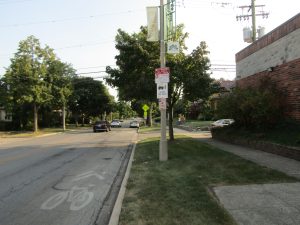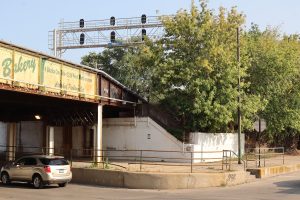Chicago area gets funds to make roads safer
By Igor Studenkov For Chronicle Media — September 18, 2024
Oak Park will be able to use federal funds to make streets like this stretch of Ridgeland Avenue more friendly for drivers, bicyclists and pedestrians. (Photo by Igor Studenkov/for Chronicle Media)
The Chicago region and other parts of Illinois got more than $32 million in federal funding to make the roads safe for drivers, bicyclists and pedestrians.
Chicago received most of the money, around $20 million, to improve a section of North Avenue in the West Humboldt Park neighborhood.
Oak Park and Harvey got around $1.1 million and $200,000, respectively, to develop plans to improve traffic safety.
The city of Waukegan got $254,365 to test out ways to make streets safer for bicyclists and pedestrians.
Winnebago County’s Highway Department got $ 234,560 to reduce speeding at dangerous intersections.
The grants all come from the U.S. Department of Transportation’s Safe Streets and Roads for All program, one of the several programs funded through the Bipartisan Infrastructure Law to address a backlog of transportation needs. The program provides grants for planning and implementation.
According to a USDOT press release, the first half of 2024 saw a decline in traffic accidents compared to the same point in 2023. However, the department emphasized that reducing car crashes is still an important priority.
“Over 40,000 people have died on U.S. roads in each of the last three years, and a disproportionate number of people are killed in rural areas or while walking or bicycling,” it stated. “Additionally, traffic fatalities remain a leading cause of death for school-aged children and young adults.”
U.S. Transportation Secretary Pete Buttigeg described the SS4A as an important step forward.

Chicago flagged the intersection of Kostner, Grand and North avenues, which is tricky to cross and has some blind spots, as one of its problem areas that need to be addressed. (Photo by Igor Studenkov/for Chronicle Media)
“We should be energized by the fact that together we’ve reduced traffic fatalities for more than two years in a row now — but so much work remains to fully address the crisis on our roads,” he said. “Today’s roadway safety grants will deliver funding directly to 354 communities and continue the important work we’re doing to reduce traffic fatalities to the only number that’s acceptable: zero.”
Chicago
North Avenue corridor has traditionally been a major commercial corridor in Chicago and the western suburbs. The Chicago project will span the section of North Avenue between Kedzie and Kostner avenues. In the less gentrified west section of Humboldt Park.
The city has resurfaced it in 2019 and 2021, but CDOT flagged several safety issues in the project. The west end is a complex three-way intersection between North, Kostner and Grand Avenues. The sidewalks under the Metra viaduct near Ridgeway Avenue have high curbs, which creates an obstacle for people with mobility issues. Several intersections are “offset” — instead of going in the straight line, the street resumes a few feet to the east, forcing the cars to make complex turns.
According to USDOT, the project will “reduce crash rates and provide safe, walkable, attractive streets that foster community access to transit and economic growth.”
CDOT is currently working on the details, with the final plan expected to be completed by 2026, but it may include “proven safety countermeasures such as bike lanes, curb extensions, bus bulb-outs, leading [traffic light] pedestrian intervals, raised crosswalks, and protected left-turn phasing.”
According to the CDOT project timeline, construction will start sometime in 2027.
Oak Park
In the fall of 2023, the Village of Oak Park launched the planning process for a Vision Zero traffic safety plan, a part of a wave of initiatives throughout the world to reduce deadly traffic accidents. According to the village, the goal is to “make mobility in the Village safer, healthier and equitable for all.” The plan is currently expected to be completed later this fall.

Chicago is getting federal funding to improve the section of North Avenue west of Kostner Avenue. (Photo by Igor Studenkov/for Chronicle Media)
The SS4A grant will go toward something that will complement that process — the development ofComplete Streets Handbook and Design Guide. Complete Streets is a planning approach that is becoming increasingly popular in urban and suburban areas, moving away from the car-centric approach to something that takes the needs of cyclists and pedestrians into account as well.
Oak Park will also be able to use the grant to field test safety measures at up to 10 intersections near parks, schools, transit stations and “high-traffic pedestrian areas.” Some of the measures include “automatic pedestrian recall,” a technical term for when pedestrian “walk” traffic signal activates automatically every time the light changes instead of requiring the pedestrian push a button, and Leading Pedestrian Interval, a technical term for when a pedestrian “walk” signal activates 3-7 minutes before the cars crossing in the same direction get a green light.
Other areas
According to USDOT, the City of Harvey will be able to use the grant similarly to Oak Park — to develop “a comprehensive safety action plan” and field-test some measures to reduce traffic fatalities. Those may include “crosswalk enhancements, intersection improvements, traffic calming measures, and speed reduction tactics.”
The term “traffic calming” broadly refers to reducing speeding by reducing the number of lanes and/or adding curb bump-outs to limit turns. The idea is that, if there are fewer lanes, there would be fewer opportunities for drivers to try to pass each other, so the traffic would naturally slow. Such projects can include bike lanes, usually between traffic lanes and street parking.

A raised sidewalk under Metra tracks can be an obstacle for people with mobility issues. (Photo by Igor Studenkov/for Chronicle Media)
Winnebago County Highway Department is getting funding to put in equipment that would “alert drivers of their speed on dangerous sections of highway, provide safe direction to the motoring public through highway department work zones, and provide safe work zones for highway department employees.”
Waukegan will be able to use its grant to put in “low-cost, high impact safety improvements at 10 historically disadvantaged locations to improve pedestrian and bicyclist safety.”
City spokesperson David Montley said that the locations in question are areas that saw a higher number of car/pedestrian and car/bicycle crashes — sections of Washington Street and parts of 10th Street, mostly near the spot where Dugdale Avenue crosses it at an angle.
According to USDOT, those improvements can include adding traffic signs, painting crosswalks, and putting in speed bumps and curb extensions. While putting in bike lanes, whether it’s simply painted lanes or lanes with barriers, would be an option, so would creating shared car/bike lanes.
“This is an opportunity for us to do a proof of concept, just to see if those measures work in slowing traffic down, reducing the amount of accidents,” Montley said, adding to see that the measures that prove to be most effective will be implemented on a broader, more permanent basis.
He said that he doesn’t have a timeline for how long the test period will last and when the longer-term improvements might be implemented.







